| George
Washington’s Flag 1775:
This was the personal flag of the
Commander-in-Chief during the Revolutionary War. A
reproduction of
this flag flies today at Washington’ Headquarters at Valley Forge, PA. |
|
| The
First Navy Jack was flown by Commodore Esik O Hopkins on
the Alfred,
flagship of the Continental Fleet, in January 1776. It has 13
alternating red & white stripes with an uncoiled rattlesnake
& the
“Don’t Tread on Me” motto. It was first used as a signal to
engage the enemy. Beginning in 1977 the ship with the longest
period of active service was to display the First Navy Jack until
decommissioned or inactive, then the flag passed to the next senior
ship. In 2002 all Navy ships began flying the First Navy
Jack. |
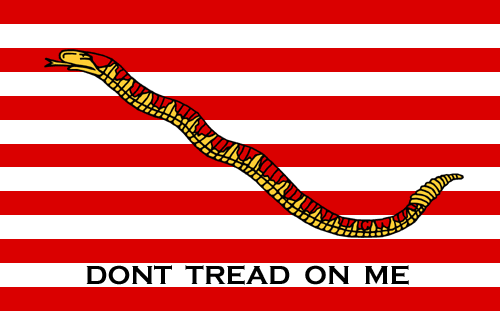 |
| Fort Moultrie Flag
- The South Carolina Militia under the command of Colonel William
moultrie repulsed a British naval attack from Fort Sullivan in
Charleston Harbort on June 28, 1776. Many historians agree that this
was one of the most decisive battles of the Revolution. The fort was
later named Fort Moultrie in the Colonel's honor. |
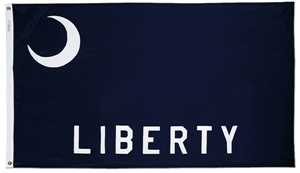 |
| Philadelphia
Light Horse Flag - The
flag of the first American armed force, the Philadelphlia City Cavalry.
The Light Horse of Philadelphia was established alongside the
Continental Congress, as the first Colonial troop without ties to
Britain. They outfitted themselves and served the Colonies as a
volunteer force under Congress. They remain today as the oldest of
America's armed forces. They fought valiantly under this banner at the
Battles of Trenton, Princeton, Brandywine, and Germantown. It was also
the first flag to have featured the thirteen stripes, each representing
a colony. |
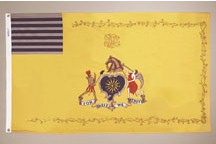 |
| Washington's
Cruiser's Flag - There
once stood an elm tree at the corner of Essex Street and Orange Street
in boston, Massachusetts, under which a group of men calling themselves
the "Sons of Liberty" met to protest the notorious British Stamp Act
sometime during 1765. From that time onward, the tree was
popularly called the "Liberty Tree." In 1775, the British seized
Boston, cut down the tree and used it for firewood. Flags bearing
the symbol of the "Liberty Tree" almost immediately began to appear.
So it is no wonder that when, in the fall of that same year,
George Washington outfitted a squadron of six schooners at his own
expense, he fittingly used the symbol of the tree and his own personal
prayer to the Lord with the phrase, "An Appeal to Heaven." |
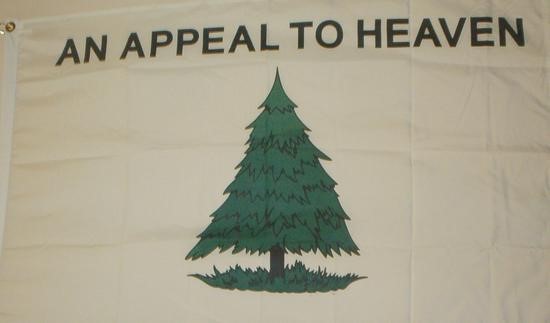 |
| Green Mountain Boys Flag
- It was first used under Ethan Allen occurred on the morning of May
10, 1775, when they silently invaded the British-held Fort Ticonderoga;
they demanded its surrender "In the name of the great Jehovah and the
Continental Congress." The captured cannon and mortars were transported
across the snow covered mountains of New England, and their
installation on the heights over Boston Harbor enabled Washington to
force the British to leave that important seaport. On August 16, 1777,
the "Green Mountain Boys" fought under General Stark at the Battle of
Bennington. It's green field represented their name and the
thirteen white s tars a tribute to the thirteen colonies. |
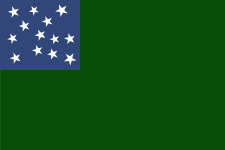 |
| The Grand
Union Flag- 1775: also known as the Continental flag, it
is the first
true U. S. Flag. It combined the British Union Jack and the
thirteen stripes signifying the Colonial unity. The thirteen
alternating red & white stripes represented the original
colonies. The use of the British Union in the upper corner
indicated a continued loyalty, as Americans then saw it, to the
government against which they fought. |
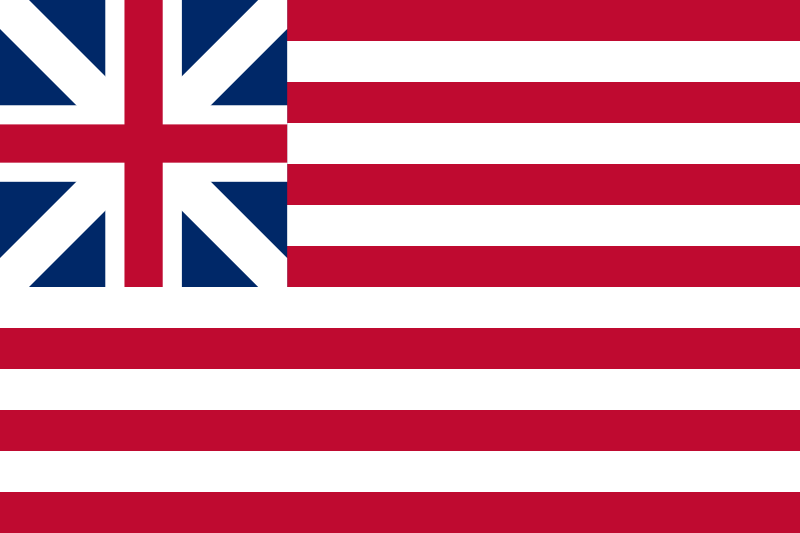 |
| The First
Stars and Stripes; also called the Betsy Ross
Flag. It is the
first official American Flag to be recognized internationally &
is
the flag that resulted from Congressional action June 14, 1777. |
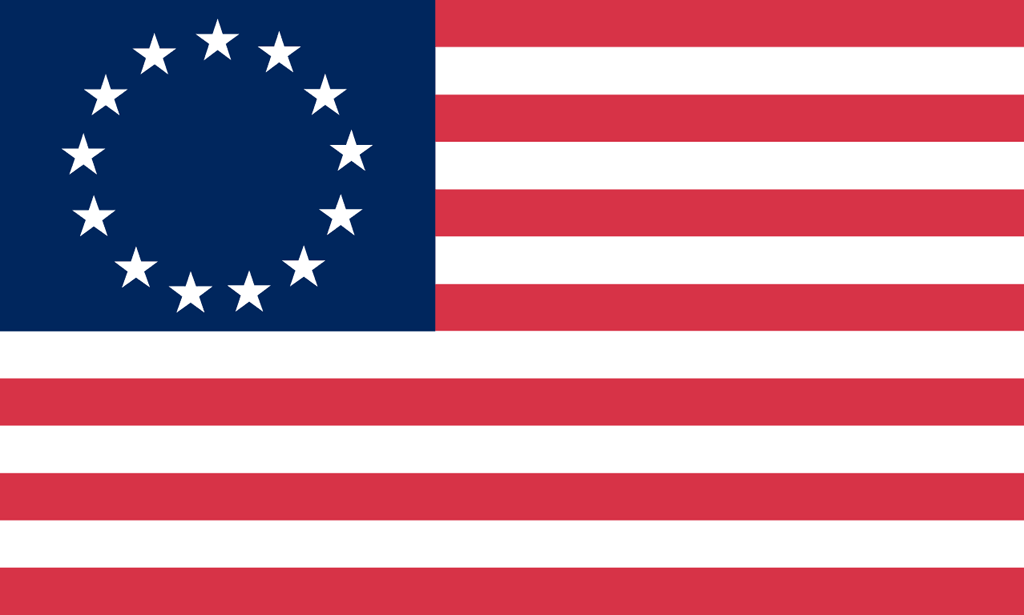 |
| The
Bennington Flag: Used in the Battle of Bennington,
Vermont, on August
16, 1777, by Vermont militia. This flag was the first to lead
American armed forces on land. It flew over the military
stores
in Bennington, when General Stark’s Militia defeated a large British
raiding force. There are seven white stripes instead of the
usual
six & only six red stripes. The original is preserved
in the
museum at Bennington, Vermont. |
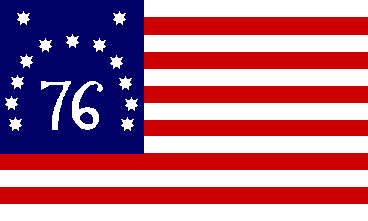 |
| The Serapes
Flag: Designed with 13 stripes alternating red, white
& blue.
Captain John Paul Jones flew this flag in the famous 1779 battle
between “the US Bon Homme Richard”& the British ship “HMS
Serapis”
in the North Sea. After winning the battle &
capturing the
HMS Serapis, John Paul Jones’ ship sank & he transferred his
flag
to the HMS Serapis. Thus his flag became known by that
name. Note too, that the stars in this flag have eight points.
It is the only flag with nonalternating stripe colors. |
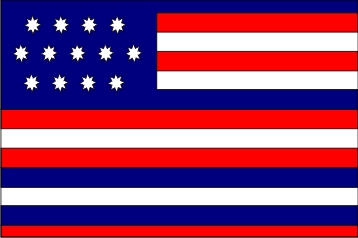 |
| The
Guilford Flag: This unusual flag was made with thirteen
8-pointed stars
in a white field. Historical records report North Carolina
Militiamen at the Battle of Guilford Courthouse, March 17, 1782,
carried this flag. You’ll note the stars are rather large
&
the 13 stripes in this flag are red & blue. |
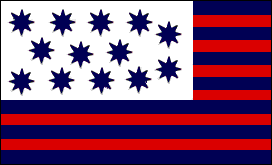 |
| The
Star Spangled Banner: Created by the Flag Act of May 1,
1795, adding 2
stripes & 2 stars for the new states of Vermont &
Kentucky. This was the flag carried by Meriwether Lewis
&
William Clark during their 1804 expedition into the Northwest
Territory. Francis Scott Key immortalized it during the
bombardment of Fort McHenry, September 13, 1814 and the only flag to
carry fifteen stripes. |
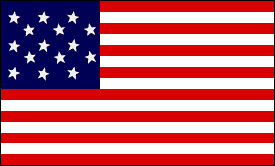 |
| The
Bedford Flag: It is the oldest complete flag known to
exist in the
United States. It is celebrated as the flag carried by the
Bedford Minuteman, Nathaniel Page, to the Concord Bridge on April 18,
1775; the beginning of the American Revolution, but it was already an
antique. It was made for a cavalry troop of the Massachusetts
Bay
militia early in the colonial struggle for the continent that we call
the “French & Indian Wars. Standard of the Minutemen
of
Bedford, MA of 1775 the original size 27 ¼“ by 29” of red damask silk
with painted emblem and motto & silver fringe.
Originally
commissioned to Cornet Page in 1737, then a royal subject of Kind
George II. On April 19, 1775, it was carried at Concord to
represent the Bedford Minutemen. Tradition says that the
fringe
from the original banner was used to trim a ball gown by Page’s great
grand daughter, who coined the words “Giddy Girl” because she regretted
losing the fringe from the flag. The original flag is encased
at
the Library at the Library at Bedford, MA. The flag’s painted
device displays an armor-clad arm issuing from a cloud &
brandishing an upraised sword, all framed by a silver border.
It
also has a gilt ribbon scroll with the motto “VINCE AUT MORIRE”
(Conquer or Die) |
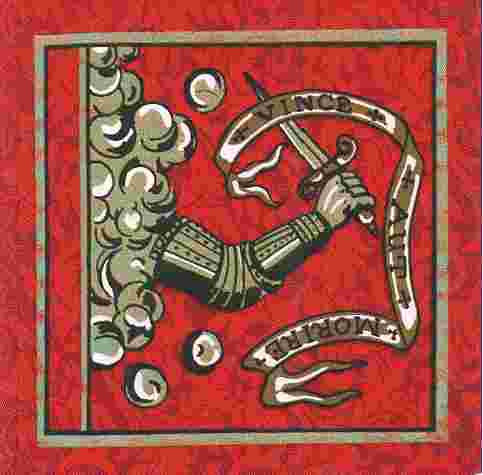 |
George
Rogers Clark Flag. This Flag was designed
& used by the
Regiment of Lt. Colonel George Rogers Clark to help capture Vincennes
IN from the British during the American Revolution. Colonel
Clark
instructed his men to reproduce the Flag in quantity, then mounted on
poles, tree limbs (whatever was available) then March around the Fort
at Vincennes. Never exposing all of his 172 troops, at any
time,
to the British; the idea was to give the appearance of a large 1000 man
American force. Some of the men would pass in sight of the
British, then duck out of sight then rush back to make another past,
waving the banners. The trick worked as the British surrendered the
Fort within two days. British commander Colonel Hamilton
turned
away, with a tear in his eye after asking Clark the question, “Where
are all your men?” Clark’s answer was “right in front of
you”.
One of the
original flags is displayed at the George
Rogers Clark’s Museum in Vincennes, IN.
The
Genl George Rogers Clark Chapter of the Illinois Society of the Sons of
the American Revolution had adopted this reproduction flag as the
Chapter’s Flag in 1990. Genevieve Hill, wife of past Chapter
President
Joe Hill made the flag & gave the flag, as their gift to the
Chapter.
|
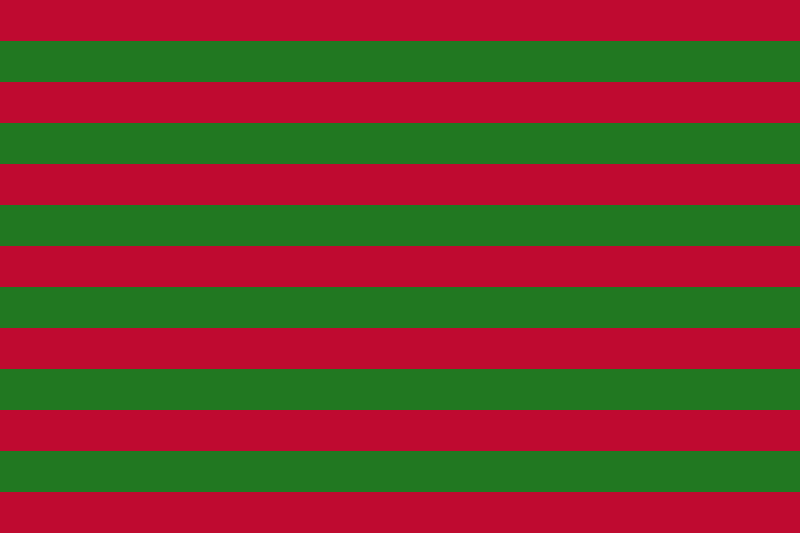 |
| The
1818 Flag: Realizing that the addition of a new Star
& a new stripe
for each new state was impractical, Congress passed the Flag Act of
1818 which returned the flag design to 13 Stripes & specified
20
stars, one for each of the 20 states then in the Union.
|
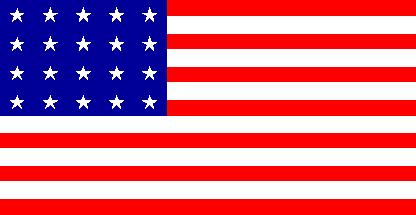 |
Confederate
Stars and Bars: The first flag of the
Confederacy. Although less
well known than the “Confederate Battle Flag”, the Stars & Bars
was
used as the official flag of the Confederacy from March 1861 to May
1863. The pattern & colors of this flag did not
distinguish
it sharply from the Stars & Stripes of the Union.
Consequently, considerable confusion was caused on the
battlefield. The Confederate Battle Flag was popularized by
the
television series “The Dukes of Hazard” which featured the “General
Lee” with the flag painted on the roof. Many mistake this
flag as
the Confederate Stars and Bars.
|
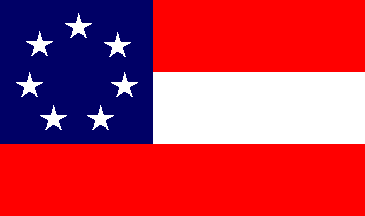 |
| Civil
War Flag: During the Civil War, Union forces used four
official flags-
consisting of 33, 34, 35 & 36 stars The 35 star U. S.
Flag
was flown most extensively during this time in our Nation’s history |
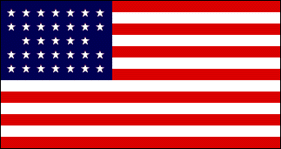 |
| The
48 Star Flag: On July 4, 1912, the U. S. Flag grew to 48
stars.
This flag was official for 47 years through two World Wars &
the
emergence of the United States of America as the leading nation of the
world. |
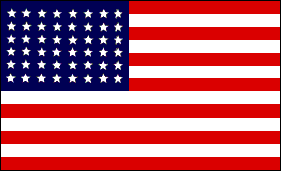 |
| The
49 Star Flag: In 1959, Alaska achieved full Statehood,
placing the 49th
star in our Flag. The 49 star flag was official for only one
year, until July 4, 1960, when Hawaii achieved Statehood and the 50
star flag was born. |
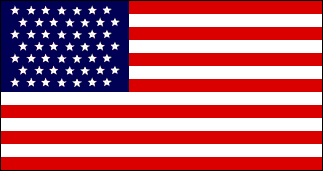 |
| The
50 Star Flag became official on July 4, 1960 with the
addition of
Hawaii to the Union. It has been the emblem of the United
States
for the many decades. Today, the official flag of the United
States of America is the most widely recognized symbol in the
world. It is the only flag to fly on another celestial
body. Our flag represents the values, traditions &
aspirations that bind us together as a Nation of diverse
individuals. There were 27 changes to the US Flags since the
1776
– 13 stars The number of stars increased from 16 to the present day 50
Star Flag. |
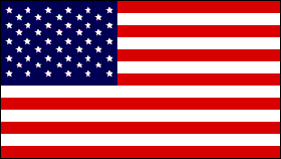 |
